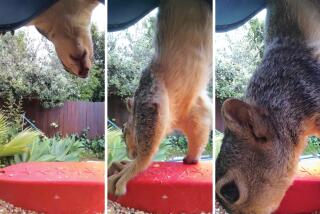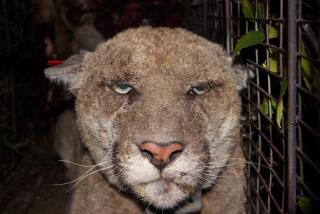Tern Predators Taking Heavy Toll : Red Foxes Face Guns, Poison
- Share via
The least tern, a small shore bird on federal and state endangered-species lists for almost two decades, may be facing its most critical breeding period this year, and those responsible for its safety are considering firearms and poison in an effort to turn the tide.
At the beginning of the breeding season in May, 94 nests were counted in the Bolsa Chica State Ecological Reserve between Huntington Beach and Seal Beach, according to Sherry Teresa, wildlife biologist for the state Department of Fish and Game.
“At last count, there were only 11 nests,” Teresa said Thursday, adding that many apparently fell prey to red foxes.
Until a few years ago, least terns numbered in the thousands of pairs, most of them wintering in Southern California after spending the summers in South America. Now, Teresa said, there probably are only 800 pairs between San Francisco and the Mexican border, and most of those are found in Orange County wetlands areas.
Although the birds, their eggs and chicks are easy prey for a wide variety of predators, their main enemy appears to be the red foxes which, ironically, are not native to Southern California.
The foxes are believed to be the offspring of animals imported to California from Missouri half a century ago for the benefit of sport hunters.
“They multiply like flies,” Teresa said of the animals.
In recent years, efforts have been made to trap red foxes, both at Bolsa Chica and at the adjacent Seal Beach Naval Weapons Station, where large numbers of least terns have nested at a national wildlife refuge on the naval base.
Teresa and her associate, Esther Burkett, a Fish and Game area biologist, said their department has trapped 17 foxes in the last year. Trapping also is being done at the weapons station, but Navy officials would not give details of the project, which has been challenged in a lawsuit filed in U.S District Court in Los Angeles.
“But the fox is only a part of the puzzle,” Teresa said Thursday. “Nests are also being raided by skunks, opossums, raccoons and even red ants. And we’re trying to fight them all.”
Trapping, which is done with “soft-jaw” traps and followed by euthanasia, may be augmented by nighttime shooting programs, Teresa said. Use of some kind of poison that would not harm other creatures also is being considered, she added.
Teresa said there is no way to estimate the number of foxes, but she emphasized that they are only a part of the concern, considering the other predators. “Our goal is not to wipe out all these animals. We hate to kill wildlife, but both we and the federal government are mandated to protect any species that is on the endangered list,” she said.
There has been opposition to the trapping and killing of the foxes. In September, 1986, a group known as the Animal Lovers Volunteers Assn. was denied an injunction that it had sought in federal court to have the trapping of foxes stopped at the naval weapons station. Following that, a panel of three judges heard oral arguments on both sides, but the original decision to deny the injunction was upheld and has been turned back to the federal courts by the 9th Circuit Court of Appeals, a U.S. Justice Department spokeswoman said Thursday.
Since growth and development along the shoreline’s wetland areas began picking up steam 15 or 20 years ago, life for the least terns has had its ups and downs.
In addition to efforts on their behalf at nesting sites in the state reserve at Bolsa Chica and the Seal Beach National Wildlife Refuge on the weapons station, the little birds got some help from a developer who spent several thousand dollars in 1973 to fix up some alternative nesting spots as replacements for those that his Huntington Harbour project would destroy.
A couple of years later, state Fish and Game wardens used shotguns to drive off a flock of crows that had been feasting on the eggs and young terns at a nesting site near the mouth of the Santa Ana River in Huntington Beach. They bagged 15 crows before the big black birds got the message and moved to other food sources.
Concern for the small sea birds dates back at least to the spring of 1970, when they were placed on the federal and state endangered species list. For successful nesting, they need flat sandy areas near saltwater estuaries. They scoop holes in the sand and lay their eggs. When the young have hatched and learned to fly, the flocks migrate to the coasts of South America to winter.
But California’s ideal breeding places also appeal to the machinations of man in the form of beachfront home sites and, in one case, the construction of a large ocean outfall line between Newport Beach and Huntington Beach, which disrupted a large tern colony that had used the sands for many years.
And their eggs, laid in a shallow hollow in the sand, remain easy prey for other creatures.
More to Read
Sign up for Essential California
The most important California stories and recommendations in your inbox every morning.
You may occasionally receive promotional content from the Los Angeles Times.










